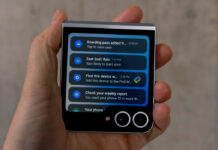
Motorola has already unveiled its reimagined Razr smartphone, but CES 2020 offered the opportunity to see how cool a newer flip might be.
If you’re old enough to remember flip phones when they were all the rage, the original Razr came to Canada in 2005. At the time, it was an innovative take on what had previously been bulkier models that looked like miniature cordless phones.
All these years later, foldable phones are set to become a thing unto themselves, and that’s where this new take on an old design comes in. This new-look device isn’t like the Samsung Galaxy Fold, or even the LG G8X ThinQ, which use two screens in different ways to fashion their own interpretations of a foldable device.

Open it up
This is more like a flip phone with a modern twist. It’s not a phone that flips out to give you a bigger screen (or two screens in LG’s case) to work with. On the outside, there’s a 2.7-inch (800 x 600) display that is surprisingly vivid and vibrant. I half expected something basic, but it is a capable screen.
Once opened up, there’s a 6-inch display to look at. Its 21:9 aspect ratio makes it wider than the usual 18:9 or 19:9 you often see in other handsets, and that means not all content will cover the whole thing. There may be black bars at the top and bottom until media apps optimize for that, so it is a caveat off the bat.
The hinge is fairly obvious because you feel it in the middle of the phone on both edges. It didn’t feel like a hindrance or anything, but it is there. Flipping the Razr open is not easily done with one hand, at least based on what I experienced in the brief time I had with it. Closing it is much easier, and it has that satisfying clapping sound too.

Close it down
When closed, the Razr has a small footprint that is unmatched by any other device currently available. There is also no gap in the fold, nor an obvious crease in the screen itself. The design philosophy and build quality are impressive at first glance.
Getting this form factor, particularly in how thin it is, had to come with shedding a few things. There is only one rear camera lens, so no multi-lens array to shoot with here. It’s a 16-megapixel image sensor bolstered by software that should theoretically offset the lack of lenses to utilize. I didn’t get the chance to take any real photos with it, so I can’t make any judgment on its merits.
This creates a rare instance whereby you can take selfies with the phone closed using the rear camera, and then flip it open to use the 5-megapixel front-facing camera. I couldn’t figure out how to open the camera when the phone was closed, and only stumbled on it accidentally. Motorola had introduced a twisting hand gesture to launch the camera way back in 2013 when it launched the Moto X. That same gesture works when the phone is closed. If there’s another way to do it, I hadn’t seen it.
There are nuances to this device that I couldn’t fully dive into. It’s the most interesting phone Motorola has released in years, and may have an impact on future phone design.



